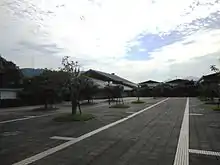Kyushu Ceramic Museum
The Kyushu Ceramics Museum (九州陶磁文化館, Kyūshū Toji Bunkakan) is a museum located in Arita town, Saga Prefecture, Japan.[1] It is one of Japan's many museums which are supported by a prefecture.[2]

Kyushu Ceramic Museum

Large dish with heron design, underglaze blue, 1690-1710s, Okawachi kiln, Hizen, Important Cultural Property

Arita ware Hakuji white porcelain hexagonal bowls and dishes, 1840–1870, late Edo period to early Meiji era
The museum was built to contribute to the local cultural heritage, and the development of ceramics and pottery culture throughout Kyūshū, southern Japan. A valuable and extensive exhibition of work such as the famous Kanbara Collection of old Imari from Europe of the 17th to 18th centuries, as well as the Shibata Collection covering Arita pottery manufactured from 1603 to 1867.
References
- "The Kyushu Ceramics Museum". Saga Prefectural. Retrieved June 28, 2011. External link in
|publisher=(help); Saga Prefecture Tourism Division, Guide To SAGA — Tourism & Products. (Brochure.) - Nussbaum, Louis-Frédéric. (2005). "Museums" in Japan Encyclopedia, pp. 671-673.
This article is issued from Wikipedia. The text is licensed under Creative Commons - Attribution - Sharealike. Additional terms may apply for the media files.